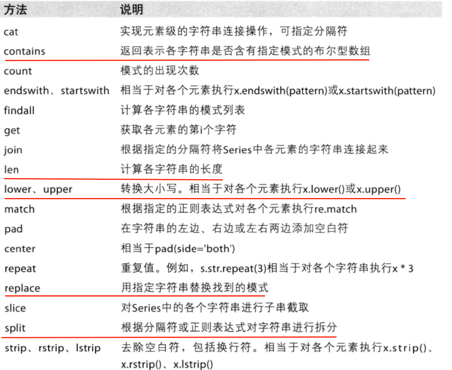Python——pandas的使用
Pandas的常用数据类型
- Series一维,带标签的数组
- DataFrame二维,Series容器
一、Series
Series对象本质上是有两个数组组成,一个数组构成对象的键(index),一个数组构成对象的值(values)
1 2 3 4 5 6 7 8 9 10 11 12 13 14 15 16 17 18 19 20 21 22 23 24 25 26 27 28 29 30 31 32 33 34 35 36 37 38 39 40 41 42 43 44 45 46 47 48 49 50 51 52 53 54 55 56 57 58 59 60 61 62 63 64 65 66 67 68 69 70 71 72 73 74 75 76 77 78 79 80 81 82 83 84 85 86 87 88 89 90 91 | import stringimport pandas as pdimport numpy as np# 创建Seriest1 = pd.Series(np.arange(5),index=list("abcde"))print(t1)"""索引可以指定,默认为012...a 0b 1c 2d 3e 4dtype: int64"""print(type(t1)) # <class 'pandas.core.series.Series'># 使用字典创建Seriesa = {string.ascii_uppercase[i]:i for i in range(5)}# 创建Seriesprint(pd.Series(a))"""A 0B 1C 2D 3E 4dtype: int64"""print(pd.Series(a,index=list("CDEFG")))"""C 2.0D 3.0E 4.0F NaNG NaNdtype: float64"""# 切片print(t1[0:4:2])"""a 0c 2dtype: int64"""print(t1[[2,3,4]])"""c 2d 3e 4dtype: int64"""print(t1[t1>2])"""d 3e 4dtype: int64"""print(t1["b"]) # 1print(t1[["a","e","f"]])"""a 0.0e 4.0f NaNdtype: float64"""# 索引和值print(t1.index) # Index(['a', 'b', 'c', 'd', 'e'], dtype='object')print(type(t1.index)) # <class 'pandas.core.indexes.base.Index'>print(t1.values) # [0 1 2 3 4]print(type(t1.values)) # <class 'numpy.ndarray'> |
二、DataFrame
创建DataFrame
1 2 3 4 5 6 7 8 9 10 11 12 13 14 15 16 17 18 19 20 21 22 23 24 25 26 27 28 29 30 31 32 33 34 35 36 37 38 39 40 | # 创建DataFrame对象t1 = pd.DataFrame(np.arange(12).reshape(3,4))print(t1)"""DataFrame对象既有行索引,又有列索引行索引,表明不同行,横向索引,叫index,0轴,axis=0列索引,表名不同列,纵向索引,叫columns,1轴,axis=1 0 1 2 30 0 1 2 31 4 5 6 72 8 9 10 11"""t2 = pd.DataFrame(np.arange(12).reshape(3,4),index=list("abc"),columns=list("EFGH"))print(t2)""" E F G Ha 0 1 2 3b 4 5 6 7c 8 9 10 11"""# 将字典转换成dataframetemp_dict = [{"name":"zhangsan","age":15,"tel":10086}, {"name":"lisi","age":15}, {"name":"wangwu","tel":10086} ]t3 = pd.DataFrame(temp_dict)print(t3)""" age name tel0 15.0 zhangsan 10086.01 15.0 lisi NaN2 NaN wangwu 10086.0""" |
获取DataFrame的基本信息
1 2 3 4 5 6 7 8 9 10 11 12 13 14 15 16 17 18 19 20 21 22 23 24 25 26 27 28 29 30 31 32 33 34 35 36 37 38 39 40 41 42 43 44 45 46 47 48 49 50 51 52 53 | # 获取DataFrame的基本信息# 行数,列数print(t1.shape)# 列数据类型print(t1.dtypes)# 数据维度print(t1.ndim) # 2# 行索引print(t1.index) # RangeIndex(start=0, stop=3, step=1)# 列索引print(t2.columns) # Index(['E', 'F', 'G', 'H'], dtype='object')# 对象值print(t1.values)"""[[ 0 1 2 3] [ 4 5 6 7] [ 8 9 10 11]]"""# 显示头几行,默认是5print(t1.head(2))# 显示末尾几行print(t1.tail(2))# 相关信息概览:行数,列数,列索引,咧非空值个数,行列类型,内存占用print(t1.info())"""<class 'pandas.core.frame.DataFrame'>RangeIndex: 3 entries, 0 to 2Data columns (total 4 columns):0 3 non-null int641 3 non-null int642 3 non-null int643 3 non-null int64dtypes: int64(4)memory usage: 176.0 bytesNone"""# 快速综合统计结果:计数,均值,标准差,最大值,1/4值,最小值print(t2.describe())"""是根据列来计算的 E F G Hcount 3.0 3.0 3.0 3.0mean 4.0 5.0 6.0 7.0std 4.0 4.0 4.0 4.0min 0.0 1.0 2.0 3.025% 2.0 3.0 4.0 5.050% 4.0 5.0 6.0 7.075% 6.0 7.0 8.0 9.0max 8.0 9.0 10.0 11.0""" |
加载csv数据
1 2 3 4 5 6 7 8 9 10 | import numpy as npimport pandas as pd# 加载csv数据t = pd.read_csv("./dogNames2.csv")# 按照字段进行排序,ascending desc/asct2 = t.sort_values("Count_AnimalName",ascending=False).head(10)print(t2) |
获取行列数据
1 2 3 4 5 6 7 8 9 10 11 12 13 14 15 16 17 18 19 20 21 22 23 24 25 26 27 28 29 30 31 32 33 34 35 36 37 38 39 40 | import stringimport numpy as npimport pandas as pd# loc和iloc方法 # df.loc:通过标签获取行数据 # df.iloc:通过位置获取行数据t1 = pd.DataFrame(np.arange(12).reshape(3,4),index=list("abc"),columns=list("EFGH"))# 获取行列交叉部分print(t1.loc["a","E"]) # 0# 获取行与多列交叉部分print(t1.loc["a",["E","F"]])"""E 0F 1"""# 获取行与多列交叉部分print(t1.loc["a","E":"G"])"""E 0F 1G 2"""# 获取行与连续多列交叉部分print(t1.loc["a":"c","G"])"""注意:loc里的:是包括最后的那个的a 2b 6c 10"""# iloc和loc是一样的,只不过采用的是索引来进行的操作 |
布尔索引
1 2 3 4 5 6 7 8 9 10 11 12 13 14 15 16 17 18 19 20 21 22 23 24 25 26 27 28 29 30 31 | import numpy as npimport pandas as pd# pandas中的布尔索引t1 = pd.read_csv("./dogNames2.csv")# 找出其中名字使用次数超过800的狗print(t1[t1["Count_AnimalName"]>800])""" Row_Labels Count_AnimalName1156 BELLA 11952660 CHARLIE 8563251 COCO 8529140 MAX 115312368 ROCKY 823"""# 找出狗名字符串长度超过4的狗print(t1[t1["Row_Labels"].str.len()>4].head(3))""" Row_Labels Count_AnimalName2 40804 13 90201 14 90203 1"""# 多条件,要使用()分割,&或|做连接符print(t1[(t1["Row_Labels"].str.len()>4)&(t1["Row_Labels"].str.len()<6)].head(3)) |
字符串方法

处理缺失数据
1 2 3 4 5 6 7 8 9 10 11 12 13 14 15 16 17 18 19 20 21 22 23 24 25 26 27 28 29 30 31 32 33 34 35 36 37 38 39 40 41 42 43 44 45 46 47 48 49 50 51 52 53 54 55 56 57 58 | import pandas as pdimport numpy as nptemp_dict = [{"name":"zhangsan","age":0,"tel":10086}, {"name":"lisi","age":15}, {"name":"wangwu","tel":10010}]t1 = pd.DataFrame(temp_dict)print(t1)""" age name tel0 15.0 zhangsan 10086.01 15.0 lisi NaN2 NaN wangwu 10010.0"""## 缺失数据的处理# - 处理方式1:删除NaN所在的行列dropna (axis=0, how='any', inplace=False)t2 = t1.dropna(axis=0, how='any', inplace=False)print(t2)""" age name tel0 15.0 zhangsan 10086.0"""# - 处理方式2:填充数据,t.fillna(t.mean()),t.fiallna(t.median()),t.fillna(0)t3 = t1.fillna(t1.mean())print(t3)""" age name tel0 15.0 zhangsan 10086.01 15.0 lisi 10048.02 15.0 wangwu 10010.0"""### 处理为0的数据:将0改为nan,然后使用上面的方法进行填充t1[t1==0] = np.nanprint(t1)### 查看是否为nan,返回布尔索引print(pd.isnull(t1))""" age name tel0 True False False1 False False True2 True False False"""print(pd.notnull(t1))""" age name tel0 False True True1 True True False2 False True True""" |



【推荐】编程新体验,更懂你的AI,立即体验豆包MarsCode编程助手
【推荐】凌霞软件回馈社区,博客园 & 1Panel & Halo 联合会员上线
【推荐】抖音旗下AI助手豆包,你的智能百科全书,全免费不限次数
【推荐】轻量又高性能的 SSH 工具 IShell:AI 加持,快人一步
· 深入理解 Mybatis 分库分表执行原理
· 如何打造一个高并发系统?
· .NET Core GC压缩(compact_phase)底层原理浅谈
· 现代计算机视觉入门之:什么是图片特征编码
· .NET 9 new features-C#13新的锁类型和语义
· Sdcb Chats 技术博客:数据库 ID 选型的曲折之路 - 从 Guid 到自增 ID,再到
· 语音处理 开源项目 EchoSharp
· 《HelloGitHub》第 106 期
· Spring AI + Ollama 实现 deepseek-r1 的API服务和调用
· 使用 Dify + LLM 构建精确任务处理应用